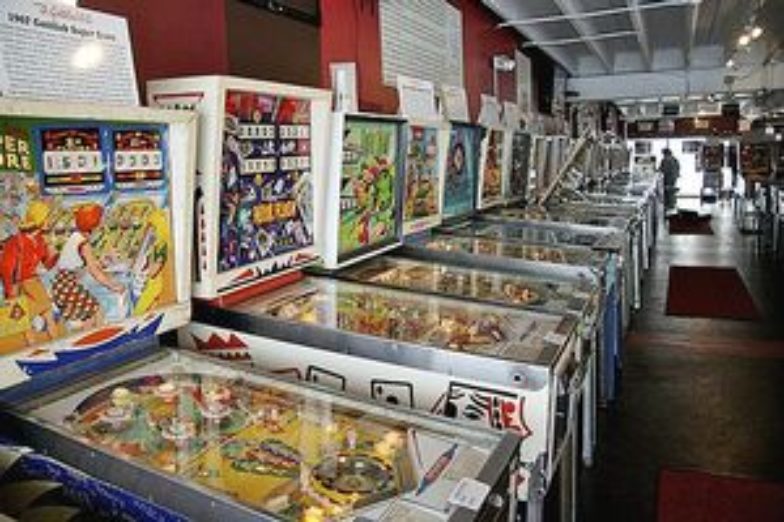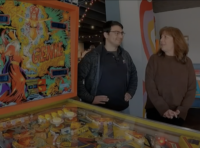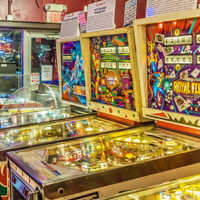Originally Published: February 25, 2010
By Paul Lukas
As The Who prepared for their Super Bowl halftime set a few weeks ago, everyone was wondering which song they’d open with. “Baba O’Riley”? “Won’t Get Fooled Again”? “Substitute”?
Instead, Pete Townshend took the stage strumming the chords to “Pinball Wizard.”
“That was pretty funny, right?” Rob Ilvento said. “We were having a Super Bowl party, and when that happened everyone said, ‘Hey, Rob, look at that!’ People got kind of excited.”
The reason for the commotion was that Ilvento is the guy behind the super-cool Silverball Pinball Museum in Asbury Park, N.J. The museum — which opened last summer and was such an instant hit that it just moved to a larger location on the boardwalk a few weeks ago — has over 180 machines, all set on free play, with historical background on each one. You can play for an hour for $10, or all day for $20. That’s a bargain for longtime pinheads (yes, that’s what pinball devotees are called) and a great crash course for Generation Xbox types.
“We want to archive this bit of Americana,” said Ilvento, who in his non-pinball life is the guy behind the Cluck-U Chicken empire. “It’s an important era in American history, and we’re going to keep it alive here.”
It looked plenty alive a few Saturdays ago, as dozens of pinheads braved the snowy weather and filled the museum with the familiar sounds of ringing bumpers and chunk-chunk-chunking score counters. “And if it’s this busy in February, just wait until we get the summer crowd,” Ilvento said.
Silverball turned out to be very ESPN-friendly, with sports-themed games based on baseball, football, college football, auto racing, horse racing, boxing, soccer, tennis, the Olympics, bowling, pool, fishing, and even dominoes (what, no curling?). This pattern of basing pinball games on other games reaches its existential peak in Super Score — a pinball-themed pinball game.
I grew up playing pinball — at the mall, at the pizza shop, at the corner deli, wherever — but it had been a long time since I’d been in a serious arcade setting, so I walked around a bit, checking out the classic old machines, getting reacclimated, feeling that old adrenaline rush. Turns out pinball is like riding a bike. It took only a few minutes before the flippers felt like organic extensions of my hands and I was rediscovering all my favorite body-English maneuvers, just like when I was a kid. Soon I was remembering the five inescapable rules that govern the pinball scene:
1. Your best, longest game will inevitably happen when you need to be somewhere else (like when you suddenly realize you need to go to the bathroom, or when you are about to meet your girlfriend for a lunch date and thought you’d play just one more quick game).
2. The same slight bump against the machine that’s fine during a crappy game will always trip the tilt mechanism during a good game.
3. Never ever touch someone else’s quarters on the top glass. (Happily, this isn’t an issue at the museum, since all the machines are set on free play.)
4. Pinball exists in an odd alternate universe that features exactly zero small-breasted women (or bras, apparently).
5. Back here in the real universe, shooting a good game of pinball will never help you score with the ladies.
But it never hurts, either.
Although many of the older games look primitive compared to the more modern digital machines, a few of the older ones at the museum have some surprising bonus features. Check out this video clip of the horse-racing game, for example:
Right next to the horse-racing machine was one of those baseball arcade games where the ball is “pitched” from the mound and then you whack it with a bat. I’d seen and played this type of game dozens of times over the years, but I’d never seen a version like the one they have at the museum, which has a nifty set of baserunners mounted on a circular track. Check it out:
Bells and whistles notwithstanding, most of the games are simply gorgeous, with spectacular artwork and snazzy graphics. Until my visit to the museum, I’d never noticed all the different styles of arrows telling where the flippers are (like, duh, where else would they be?).
The museum and its collection of machines have the feel of a lifelong labor of love, but Ilvento wasn’t bitten by the pinball bug until about seven years ago, when he noticed that his autistic daughter was able to occupy herself for a solid half-hour with a pinball game. “So I bought a machine,” he recalled. “And then one game led to two, and then I had seven or eight in my living room, and then 20 or 30, and then … ” He now has over 220 machines and continues to acquire two or three per week. Most of them run about $3,000, although he’ll pay a lot more for something rare.
Since the museum’s capacity is maxed out at 182 machines, Ilvento and his staff rotate the games in and out of the museum, which works out well because the machines need plenty of regular maintenance. “The older ones you can fix, because they’re just mechanical, and they can theoretically last forever,” Ilvento said. “The newer ones are run by computer chips, and once they stop making those chips, those machines will end up in the trash, like old cell phones.”
Ilvento doesn’t do any of the repair work himself, but he has a crew of technicians and restoration specialists who take the games apart and keep everything working smoothly. Here’s one of them, Ray Laraway, describing his work on an old machine:
So who comes to a place like Silverball? If you’re thinking “Probably lots of old-fogey nerds,” yeah, there were some of those. But I also saw plenty of 20-something couples, several fathers giving pointers to their grade-school kids (sort of the pinball equivalent of tossing the ball around with your little boy), and even a couple of families. Everyone was having a good time — so good that several of them didn’t mind talking to me while they played:
As for the future, Ilvento is bullish on pinball, or at least on his museum concept. “We may do a little chain of them, maybe in Times Square, Chicago, even Beijing,” he said. “You can’t really duplicate the same museum, because the machines are hard to find, but there are other collectors who want to work with us now that we’re in the business. Who wouldn’t want to run a pinball museum?”
Pinball’s own future may be a bit murkier. Video games (which Ilvento says he “doesn’t believe in”), the Internet, iPhones and all the rest have relegated pinball to the fringes of the entertainment world. Only one manufacturer remains: Stern, which produces just a couple of new designs each year.
But that’s fine by Ilvento. “There’s still an audience for it, and there’s no better place for that audience than here at our museum,” he said. “It’s like a slice of pizza — other foods may come along, but people are still gonna love a good slice of pizza. It’s the same with pinball.”
Hmmm … that analogy might hold up a bit better if all those slice joints still had a pinball machine in the corner. Still, Ilvento’s enthusiasm is infectious. He’s an appealing guardian of the flame (or maybe the flashing bumper), determined to ensure that the two saddest words in the pinball lexicon will never apply to pinball as a whole — at least not if he has anything to say about it.







